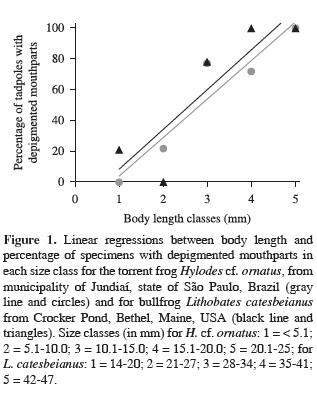A fungal pathogen Batrachochytrium dendrobatidis (Bd), which can cause morbidity and death of anurans, has affected amphibian populations on a worldwide basis. Availability of pure cultures of Bd isolates is essential for experimental studies to understand the ecology of this pathogen. We evaluated the relationships of body length of Hylodes cf. ornatus and Lithobates catesbeianus tadpoles to depigmentation of mouthparts and determined if dekeratinization indicated an infection by Batrachochytrium dendrobatidis. A strong association existed for both species, one from South America (Brazil: São Paulo) and one from North America (USA: Maine). We believe it prudent not to kill adult amphibians if avoidable, thus obtaining tissue for isolating Bd from tadpoles is reasonable because infected specimens of some species can be selectively collected based on depigmentation of mouthparts.
Batrachochytrium dendrobatidis; depigmentation; Hylodes cf. ornatus; Lithobates catesbeianus; tadpole


